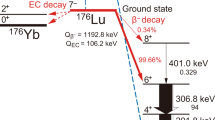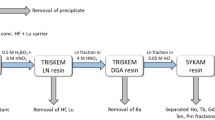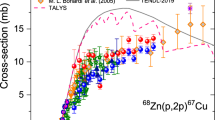Abstract
THE specific γ-activity of ordinary potassium, in the form of ‘AnalaR’ potassium chloride, has been determined by the following procedure: (1) A source of potassium-42 (obtained by the irradiation of ‘Specpure’ potassium carbonate in the Harwell pile) was calibrated against a standard radium needle using a small carbon-walled ionization chamber. (2) The response was measured to a solution containing 1,745 gm. potassium (as ‘AnalaR’ potassium chloride), using a large differential high-pressure ionization chamber apparatus. (A description of this apparatus will be given elsewhere.) (3) A measured aliquot of a solution of the calibrated potassium-42 was added to the potassium chloride solution and the additional response observed as in (2). (4) The half-life of the potassium-42 was measured with the large ionization chamber apparatus and found to be (± probable error) 12.516 ± 0.007 hr. Analysis was by the method of least squares and each point on the decay curve was weighted on an experimental basis. It was necessary to correct for the presence of a small amount of unidentified long-lived activity with an apparent half-life of about 177 days. Sodium lines were reported in the spectrographic analysis, although the percentage contamination was not given; the half-life result will therefore tend to be slightly greater than that of absolutely pure potassium-42, because of the presence of some sodium-24 of half-life 15.0 hr.
This is a preview of subscription content, access via your institution
Access options
Subscribe to this journal
Receive 51 print issues and online access
$199.00 per year
only $3.90 per issue
Buy this article
- Purchase on Springer Link
- Instant access to full article PDF
Prices may be subject to local taxes which are calculated during checkout
Similar content being viewed by others
References
Halpern, O., and Hall, H., Phys. Rev., 73, 477 (1948). Sternheimer, R. M., Phys. Rev., 88, 851 (1952).
Taylor, L. S., and Singer, G., Amer. J. Roentgenol., 44, 428 (1940).
Bell, P. R., and Cassidy, J. M., Phys. Rev., 79, 173 (1950). Good, M. L., Phys. Rev., 81, 891 (1951).
Evans, R. D., and Evans, R. O., Rev. Mod. Phys., 20, 305 (1948).
Sawyer, G. A., Weidenbeck, M. L., Phys. Rev., 79, 490 (1950).
Spiers, F. W., Nature, 165, 356 (1950).
Faust, Phys. Rev., 78, 624 (1950).
Gráf, T., Rev. Sci. Instr., 21 (1950).
Paganelli, M., and Quareni, G., Phys. Rev., 86, 423 (1952). Johnson, W. H., Phys. Rev., 88, 1213 (1952).
Gráf, T., Phys. Rev., 74, 831 (1948). Good, M. L., Phys. Rev., 83, 1054 (1951).
Mousuf, A. K., Phys. Rev., 87, 150 (1952).
Nier, A. O., Phys. Rev., 77, 789 (1950).
Author information
Authors and Affiliations
Rights and permissions
About this article
Cite this article
BURCH, P. Specific γ-Activity, the Branching Ratio and Half-life of Potassium-40. Nature 172, 361–362 (1953). https://doi.org/10.1038/172361a0
Issue Date:
DOI: https://doi.org/10.1038/172361a0
This article is cited by
-
Is there any health danger by radioactivity on the use of dimensional stones?
Environmental Earth Sciences (2022)
-
Altersbestimmung nach der K-Ar-Methode
Geologische Rundschau (1960)
Comments
By submitting a comment you agree to abide by our Terms and Community Guidelines. If you find something abusive or that does not comply with our terms or guidelines please flag it as inappropriate.



